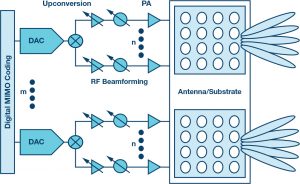With 5G rising on the horizon, it’s an exciting time to be an RF engineer. As we embark on the road to 5G, the next-generation wireless communications system, there are countless challenges and opportunities emerging for the engineering community. 5G represents both an evolution and a revolution of mobile technologies that reaches the various high level goals that have been published to date by various members of the wireless ecosystem.
5G is widely seen as the generation of wireless that will enable cellular to expand into a completely new set of use, case, and vertical markets. While
5G is generally seen in technology that delivers ultrabroadband services, including HD and ultraHD video streaming, 5G technology will also enable cellular to enter the world of machines. It will contribute to autonomous vehicles and be used to connect millions of industrial sensors and a multitude of wearable consumer devices, to name a few applications.
The evolutionary path to 5G consists of incremental enhancements of 4G in the conventional cellular bands and extending up in frequency to emerging bands in the 3 GHz to 6 GHz range. Massive MIMO has industry momentum and will evolve from first systems based on LTE to adopt new waveforms designed to improve throughput, latency, and cell efficiency.

Figure 1. Block diagram of hybrid beamforming transmitter.
Spectrum is seen as the lifeblood of the cellular industry and the spectrum in the legacy cellular bands (sub-6 GHz) just cannot support the exponentially growing demand in upcoming years. As such, the bands above 6 GHz are currently under study to test the viability of deploying wireless access in frequency allocations above 6 GHz. While the collective global spectrum available below 6 GHz is on the order of hundreds of MHz, the amount of potential spectrum above 20 GHz is in the tens of GHz. The taming of this spectrum is considered essential to achieve the 5G vision of a truly connected world.
As a result, a segment of 5G is likely to operate on much higher frequencies (possibly up to millimeter waves) and will likely adopt new air interface technologies that are not backward compatible to LTE.
The frequency bands discussed among key industry players include higher frequency bands such as 10 GHz, 28 GHz, 32 GHz, 43 GHz, 46 GHz to 50 GHz, 56 GHz to 76 GHz, and 81 GHz to 86 GHz. However, these bands are currently in the proposal stages and much work remains to be completed in channel modeling prior to the radio systems definitions and standards deliberations.
The ITU recently published a plan for 5G standardization with a target to publish the first generation of IMT-2020 specifications around year 2020.
Given that the 5G is still in its infancy, much work needs to be completed in the channel modeling, radio architecture definition, and finally chipset development before the first commercial systems will be deployed.
However, there are certain trends and requirements already agreed upon and problems to be solved that will lead to the final 5G systems.
Let’s consider 5G access systems at microwave and millimeter wave frequencies. One of the major hurdles in implementing radio access at microwave frequency is overcoming the unfavorable propagation characteristics. Radio propagation at these frequencies is highly affected by atmospheric attenuation, rain, blockage (buildings, people, foliage),
and reflections. Microwave point-to-point links have been deployed for many years but these are generally line of sight systems. The fact that they are stationary makes the link manageable, and the systems have been developed in recent years, which support very high throughput using high order modulation schemes. This technology continues to evolve and we will leverage the microwave link technologies into 5G access.
Early in the cycle, it has been acknowledged that adaptive beamforming will be required to overcome the propagation challenges for access systems.
Unlike point-to-point systems, the beamforming will need to adapt to the users and the environment to deliver the payload to the user. It is generally agreed in the industry that hybrid MIMO systems will be used in the microwave and low millimeter wave bands, while in V bands and E bands – where bandwidth is plentiful – the systems will likely only employ beamforming to reach the required throughput goals.
The diagram in Figure 1 depicts a high level block diagram of the hybrid beamforming transmitter. The receiver can be envisioned as the reverse. The MIMO coding is performed in the digital section along with the typical digital radio processing. There may be a multitude of MIMO paths processed in the digital section from the various data streams feeding the antenna system. For each data stream, the DAC converts the signal into analog at either a baseband or IF frequency depending on the selected architecture. The signal is upconverted and split into the constituent RF paths to feed individual antennae. In each RF path, the signal is processed to set the gain and phase to form the beam out of the antenna.
While the block diagram is simplistic, the system challenges and tradeoffs are complex. In this short treatment of the topic only a few issues will be discussed, but let’s focus on the architecture and radio challenges. It is critical to design this system with power, size, and cost in mind from the start to bring these systems to reality.
While such radios can and are being built today for prototype 5G systems
using discrete (mainly GaAs) devices from Analog Devices and our peers, we need to bring the same high levels of integration to bear in the microwave space as what has been implemented in cellular radios.
High integration and high performance make a tough problem for the industry to solve.
But integration alone is not the solution to this problem facing the industry.
It needs to be smart integration. When we think of integration, we need to first consider architecture and partition to leverage the benefits of integration. In this case mechanical and thermal design also need to be considered as the circuit layout and substrate are interrelated.
First of all, an architecture conducive to integration needs to be defined. If
we consider the examples of highly integrated transceiver ICs for cellular
base stations, many use a zero IF (ZIF) architecture to either eliminate or minimize the filtering in the signal path. Particularly at microwave frequency, one must minimize the loss in the RF filters, as RF power is expensive to generate. While ZIF will reduce the filter issue, of course the trade-off is LO suppression, but we shift the problem from physical structures to signal processing and algorithms. Here we can leverage Moore’s law, whereby passive microwave structures do not follow the same scaling dynamics. It is necessary to take advantage of the ability to optimize analog and digital simultaneously to reach our goals. There are many algorithms and circuit techniques that have been employed at cellular frequency that may bring benefits to the microwave space.
Next, consider the semiconductor technology requirements. As mentioned above, state-of-the-art microwave systems are generally implemented with GaAs components. GaAs has been the mainstay of the microwave industry for many years, but SiGe processes are overcoming the barriers of high frequency operation to rival GaAs in many of the signal path functions. High performance microwave SiGe Bi CMOS processes enable a high level of integration required for these beamforming systems encompassing much of the signal chain as well as auxiliary control functions.
GaAs PAs may be required, depending on the output power required at each antenna. However, even GaAs PAs are inefficient at microwave frequency as they are generally biased in the linear region. Linearization of microwave PAs is an area ripe for exploration in the 5G era, more than ever before.
What about CMOS? Is it also a contender? It is well documented that CMOS is suited for high volume scaling and this is being proven out in WiGig systems at 60 GHz. Given the early stage of development and uncertainty
of the use cases, it is difficult to say at this point if or when CMOS will be a technology choice for the 5G radios. Much work needs to be done first in the channel modeling and use cases to conclude the radio specifications and where microwave CMOS may fit in future systems.
The final consideration in the 5G systems is the interdependency of the mechanical design and RF IC partitioning. Given the challenges to
minimizing losses, the IC needs to be designed with the antenna and substrate in mind to optimize the partition. Below 50 GHz, the antenna
will be part of the substrate and it is expected that the routing and some passive structures may be embedded in the substrate. There is a body of research ongoing in the area of substrate integrated waveguides (SIW) that looks promising for such integrated structures. In such a structure it will be possible to mount much of the RF circuitry on one side of the multilayer laminate and route to the antennae on the front face. The RF ICs may be mounted in die form on this laminate or in surface-mount packages. There are good examples in the industry literature of such structures for other applications.
Above 50 GHz, the antenna elements and spacing become small enough that it is possible to integrate the antenna structure in or on the package. Again, oing research that may push 5G systems forward.
In either case, the RF IC and mechanical structure must be codesigned to ensure symmetry in routing and to minimize losses. None of this work will be possible without powerful 3D modeling tools for the extensive simulations required for these designs.
While this is a brief perspective on the challenges 5G brings to the microwave industry, there are boundless opportunities to bring forth RF innovations in the coming years. As mentioned previously, a rigorous systems engineering approach will yield the optimum solution by leveraging the best technologies throughout the signal chain. There is much work to be done as an industry from processes and materials develop to design techniques and modeling, to high frequency test and manufacturing. All disciplines have a role to play in reaching the 5G goals.
Analog Devices brings a strong contribution to the 5G microwave effort with our unique bits to microwave capability. Our broad technology portfolio and continued RF technology advances combined with our rich
history in radio systems engineering put ADI in a leading position to
pioneer new solutions for our customers at microwave and millimeter wave frequencies for the emerging 5G systems.
As mentioned in the beginning of the article, it is an exciting time to be an
RF engineer in the wireless industry. 5G is just starting and there is much
work ahead of us to realize commercial 5G radio networks by 2020.
About the Author
Dr. Thomas Cameron is the CTO for the Communications Business Unit at Analog Devices. In this role he contributes to industryleading innovation in integrated circuits for radio base stations and microwave backhaul systems. He is currently working on research and development of radio technology for 5G systems in both cellular and microwave frequency bands. Prior to his current role at Analog Devices he was Director of Systems Engineering for the Communications Business.
Dr. Cameron has over 30 years of experience in research and development of technology for telecom networks including cellular base stations, microwave radios, and cable systems. Prior to joining Analog Devices in 2006, he had worked on developing numerous RF circuits and systems over his career at Bell Northern Research, Nortel, Sirenza Microdevices, and WJ Communications.
Dr. Cameron holds a Ph.D. in electrical engineering from the Georgia Institute of Technology.







